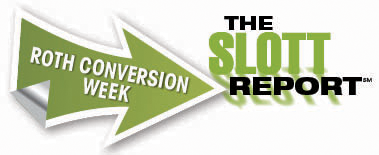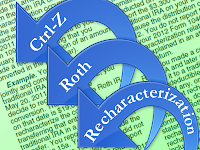Yesterday, the IRS released a "Taxpayer Bill of Rights," to help organize "the dozens of existing rights in the Internal Revenue Code into ten fundamental rights," as well as make the "rights clear, understandable, and accessible for taxpayers and IRS employees alike."
With that in mind, it occurred to me that IRA owners would benefit from an "IRA Owners’ Bill of Rights," of sorts, to help understand certain aspects of their retirement accounts. Below is a list of 10 key rights that any and all IRA owners should be aware they have. Before we get to that, however, just two quick, important notes regarding the list:
2. You have the right to convert any or all of your traditional IRA to a Roth IRA at any time. There are no age limits, income limits, earnings requirements, dollar amount limits, etc. It’s your call when and if to do it, and if so, for how much. Period.
3. You have the right to recharacterize (undo) all or any portion of a Roth IRA conversion for any reason up until October 15 of the calendar year following the year you convert. This is one of the few tax-planning strategies you can change your mind about well after the fact and essentially go back in time as if it never happened.
4. You have the right to name anyone you want as your beneficiary. Unlike certain qualified plans subject to ERISA rules, like 401(k)s, your spouse does not have to be your beneficiary. Your beneficiary can be your spouse, but it could also be your children, grandchildren, a charity, a trust, or any other person or entity you so choose. (Note: If you live in a community property state, your spouse may automatically be entitled to a portion of your IRA under state law)
5. You have the right to change your beneficiaries at any time. This is one of the rights you should always be sure to exercise when circumstances change. Anytime there is a birth, death, marriage, divorce or other life event, you should check to make sure your beneficiary form still aligns with your wishes.
6. You have the right to take a distribution from your account at any time. There is nothing in the tax code that prevents you from taking money out of your IRA when and if you want it. That said, there are obviously consequences for any actions you take, such as the 10% early distribution penalty for pre age 59 ½ distributions, so just be smart about when you choose to exercise this right.
7. You have the right to withhold 0%, 10%, or more than 10% from your IRA distributions. This differs from plan rules, where there is generally a mandatory withholding of 20% on all pre-tax distributions. Just because you have the right to forgo withholding, though, doesn’t mean you should. Always check with your tax professional to make sure that your withholding choices are in line with your overall tax plan so you avoid unnecessary penalties.
8. You have the right to invest in just about anything you want, other than life insurance, S-Corp stock and collectibles.
9. Your have the right to do whatever you want with your retirement funds, after you distribute them. Want to purchase life insurance or S-Corp stock? No problem. Just take a distribution from your IRA. Once the money is out of your IRA and you’ve paid tax on it, it’s “regular” money… and best of all, it’s yours to do whatever you want with!
10. You have the right to make good decisions that will save you valuable tax dollars and make your retirement account worth much more over the course of your life and the lives of your beneficiaries. Similarly, you also have the right to make poor choices that will cost you and your loved ones valuable tax dollars. The choice of which of these rights to exercise is up to you, so always make sure you evaluate your decisions carefully, have a plan and stick to it. And when in doubt, remember that you also have the right to seek advice from a qualified professional.
- By Jeffrey Levine and Jared Trexler
With that in mind, it occurred to me that IRA owners would benefit from an "IRA Owners’ Bill of Rights," of sorts, to help understand certain aspects of their retirement accounts. Below is a list of 10 key rights that any and all IRA owners should be aware they have. Before we get to that, however, just two quick, important notes regarding the list:
- This is an IRA Owners’ Bill of Rights list. In some cases, the rules for plans, like 401(k)s, are different.
- These rules are the rules that are allowed under the tax code. In certain situations, your “rights” can (but may not necessarily) be limited by your IRA custodian.
The IRA Owners’ Bill of Rights
1. You have the right to move your IRA account at any time, and as often as you like, from one IRA custodian to another via a direct transfer. Note that this right does not apply to 60-day rollovers.2. You have the right to convert any or all of your traditional IRA to a Roth IRA at any time. There are no age limits, income limits, earnings requirements, dollar amount limits, etc. It’s your call when and if to do it, and if so, for how much. Period.
3. You have the right to recharacterize (undo) all or any portion of a Roth IRA conversion for any reason up until October 15 of the calendar year following the year you convert. This is one of the few tax-planning strategies you can change your mind about well after the fact and essentially go back in time as if it never happened.
4. You have the right to name anyone you want as your beneficiary. Unlike certain qualified plans subject to ERISA rules, like 401(k)s, your spouse does not have to be your beneficiary. Your beneficiary can be your spouse, but it could also be your children, grandchildren, a charity, a trust, or any other person or entity you so choose. (Note: If you live in a community property state, your spouse may automatically be entitled to a portion of your IRA under state law)
5. You have the right to change your beneficiaries at any time. This is one of the rights you should always be sure to exercise when circumstances change. Anytime there is a birth, death, marriage, divorce or other life event, you should check to make sure your beneficiary form still aligns with your wishes.
6. You have the right to take a distribution from your account at any time. There is nothing in the tax code that prevents you from taking money out of your IRA when and if you want it. That said, there are obviously consequences for any actions you take, such as the 10% early distribution penalty for pre age 59 ½ distributions, so just be smart about when you choose to exercise this right.
7. You have the right to withhold 0%, 10%, or more than 10% from your IRA distributions. This differs from plan rules, where there is generally a mandatory withholding of 20% on all pre-tax distributions. Just because you have the right to forgo withholding, though, doesn’t mean you should. Always check with your tax professional to make sure that your withholding choices are in line with your overall tax plan so you avoid unnecessary penalties.
8. You have the right to invest in just about anything you want, other than life insurance, S-Corp stock and collectibles.
9. Your have the right to do whatever you want with your retirement funds, after you distribute them. Want to purchase life insurance or S-Corp stock? No problem. Just take a distribution from your IRA. Once the money is out of your IRA and you’ve paid tax on it, it’s “regular” money… and best of all, it’s yours to do whatever you want with!
10. You have the right to make good decisions that will save you valuable tax dollars and make your retirement account worth much more over the course of your life and the lives of your beneficiaries. Similarly, you also have the right to make poor choices that will cost you and your loved ones valuable tax dollars. The choice of which of these rights to exercise is up to you, so always make sure you evaluate your decisions carefully, have a plan and stick to it. And when in doubt, remember that you also have the right to seek advice from a qualified professional.
- By Jeffrey Levine and Jared Trexler


























